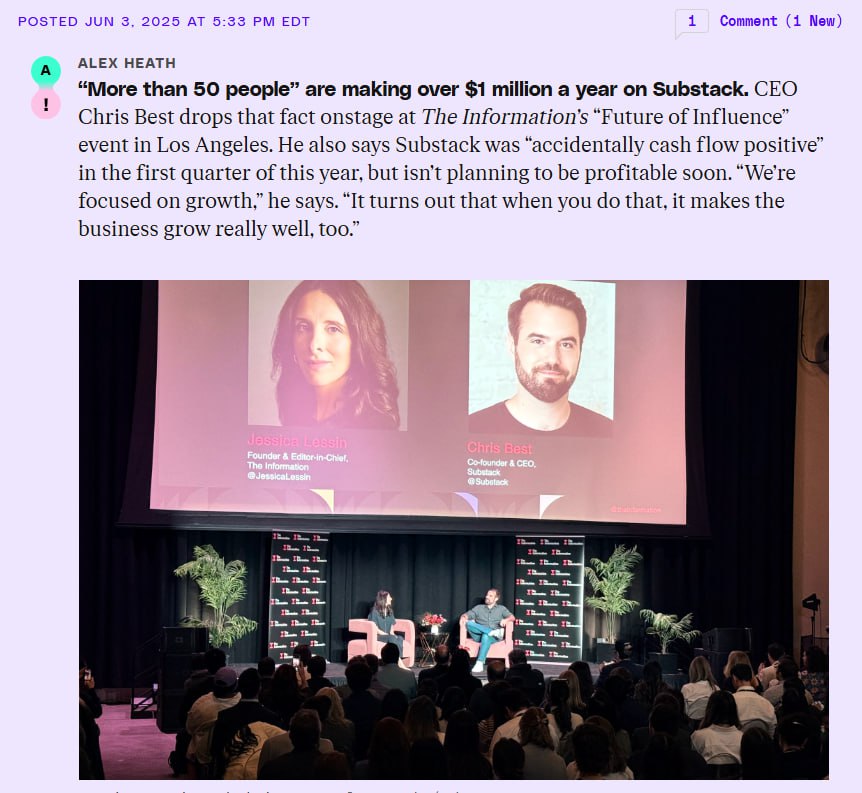On June 3, 2025, Substack CEO Chris Best shared a staggering milestone: more than 50 authors on the platform are now earning over $1 million annually through paid subscriptions alone.
This revelation, reported by The Verge, highlights the transformative potential of Substack’s subscription-based model for independent writers. Imagine telling someone just a couple of years ago that a newsletter platform would enable dozens of creators to reach seven-figure incomes without relying on ads or traditional media structures — it would have sounded like a pipe dream.

Yet, Substack has made this a reality, reshaping the creator economy and offering a glimpse into the future of independent publishing.
A New Era for Writers
 Founded in 2017, Substack set out to empower writers by allowing them to connect directly with their audiences through newsletters, monetizing their work via paid subscriptions.
Founded in 2017, Substack set out to empower writers by allowing them to connect directly with their audiences through newsletters, monetizing their work via paid subscriptions.
The platform takes a 10% cut of subscription revenue, with additional fees from payment processor Stripe, but leaves the rest to the creators.
Unlike traditional media, Substack doesn’t rely on ad revenue, giving writers full control over their content and audience relationships. This model has proven lucrative for top earners, with the platform’s top 10 authors collectively generating $40 million a year, according to a recent Wall Street Journal report cited by Press Gazette.
The idea that over 50 authors are now millionaires through Substack subscriptions alone is a testament to the platform’s growth.
As of early 2025, Substack boasts over 35 million active subscriptions, including more than 5 million paid ones, per company updates.
This is a significant leap from November 2021, when the platform reported 1 million paid subscriptions. The growth reflects a broader trend: readers are increasingly willing to pay for high-quality, direct-from-the-creator content, especially as trust in traditional media wanes.
What This Means for Creators
 The $1 million milestone isn’t just a number — it’s a signal of what’s possible for independent creators. Substack’s model allows writers to set their own subscription prices, typically starting at $5 per month, though some charge significantly more for niche or professional content.
The $1 million milestone isn’t just a number — it’s a signal of what’s possible for independent creators. Substack’s model allows writers to set their own subscription prices, typically starting at $5 per month, though some charge significantly more for niche or professional content.
For example, a writer with 10,000 subscribers at $10 per month could gross $1.2 million annually before fees. While this is an oversimplification — Stripe fees and taxes reduce net earnings—the potential is clear.
Notably, many of Substack’s top earners didn’t start from scratch. Authors like Leslie of The Morning Person, who brought 20,000 Instagram followers to Substack in 2021, leveraged existing audiences to hit over 5,000 paid subscribers by late 2022, earning over $25,000 monthly.
Others, like Bari Weiss of The Free Press, have turned their newsletters into full-fledged media operations, with Weiss reportedly generating millions annually while employing a 50-person staff.
These success stories often involve creators with established followings, but Substack’s recommendation system and network effects have also helped lesser-known writers grow.
A Reality Check: Not Everyone Strikes Gold
 While the headline of 50+ millionaires is impressive, it’s worth examining the broader picture. Substack has over 17,000 writers running paid newsletters, meaning the millionaires represent less than 0.3% of paid creators. Press Gazette’s 2025 analysis found that 52 newsletters earn at least $500,000 annually, collectively generating $40.2 million, but the average earnings for most writers are far lower.
While the headline of 50+ millionaires is impressive, it’s worth examining the broader picture. Substack has over 17,000 writers running paid newsletters, meaning the millionaires represent less than 0.3% of paid creators. Press Gazette’s 2025 analysis found that 52 newsletters earn at least $500,000 annually, collectively generating $40.2 million, but the average earnings for most writers are far lower.
If the remaining $300 million Substack has paid out to writers (as reported in 2023) were distributed equally among the other 16,975 paid writers, each would earn just $16,200 annually — hardly a living wage for most.
This disparity highlights a critical truth: Substack’s model rewards those who can build large, engaged audiences, often through pre-existing platforms like X or Instagram.
Writers without such a head start face an uphill battle, as converting free subscribers to paid ones typically yields a 5-10% conversion rate. For every success story, thousands of writers earn modest sums or struggle to gain traction, a reality that tempers the platform’s utopian promise.
Looking Back: Would We Have Believed This in 2023?
 Two years ago, in mid-2023, Substack was already making waves, but the scale of its current success would have been hard to fathom. Back then, Press Gazette reported that 27 newsletters were earning at least $500,000 annually, with at least five hitting $1 million.
Two years ago, in mid-2023, Substack was already making waves, but the scale of its current success would have been hard to fathom. Back then, Press Gazette reported that 27 newsletters were earning at least $500,000 annually, with at least five hitting $1 million.
The top 10 authors were collectively earning $25 million, a figure that has since risen to $40 million.
The idea that this number would double to over 50 millionaires by 2025 would have seemed ambitious, if not implausible, especially given concerns about subscription fatigue. As Nick Hilton warned in 2023 on his Substack Futureproof News, the proliferation of paid newsletters risked overwhelming audiences, who might not sustain multiple $5-$10 monthly subscriptions.
Yet, Substack defied these concerns, capitalizing on a growing appetite for independent, ad-free content.
The platform’s traffic surged, with 95 million visits in December 2024, up 40% from the previous year, earning it Similarweb’s “Digital Winner” award. High-profile journalists like Jen Rubin, who launched The Contrarian in early 2025 after leaving The Washington Post, quickly amassed tens of thousands of paid subscribers, further fueling Substack’s momentum.
Also read:
- ElevenLabs Pays Out Over $5 Million to Voice Actors and Creators: A New Era of Passive Income
- Stan Store Secures Major Investment from Steven Bartlett for a Double-Digit Stake: A Game-Changer for Creator-Focused Platforms
- Netflix Launches Interactive Reality Show "House of Streams," Where Content Creators Battle for Bitcoin
What’s Next for Substack?
 The milestone of 50+ authors earning $1 million annually is a win for Substack, but it also raises questions about sustainability. The platform isn’t yet profitable, though it was cash flow positive in Q1 2025, per The Verge. As competition in the creator economy heats up — with platforms like Beehiiv and ConvertKit offering similar subscription tools — Substack must continue to innovate.
The milestone of 50+ authors earning $1 million annually is a win for Substack, but it also raises questions about sustainability. The platform isn’t yet profitable, though it was cash flow positive in Q1 2025, per The Verge. As competition in the creator economy heats up — with platforms like Beehiiv and ConvertKit offering similar subscription tools — Substack must continue to innovate.
Features like Substack Chat, video functionality, and the Substack Reader app have expanded its offerings, but the core appeal remains its simplicity: a platform where writers can focus on creating while earning directly from their audience.
For aspiring creators, Substack’s success stories are both inspiring and cautionary. The platform offers a path to financial independence, but it’s not a guaranteed one. Building a million-dollar newsletter requires a compelling niche, a loyal audience, and often a pre-existing following.
Still, the fact that over 50 writers have achieved this in 2025 — something that would have seemed far-fetched just two years ago—shows that the creator economy is evolving, and Substack is at the forefront of that change.
Whether this growth continues, or subscription fatigue sets in, will shape the next chapter of independent publishing.






